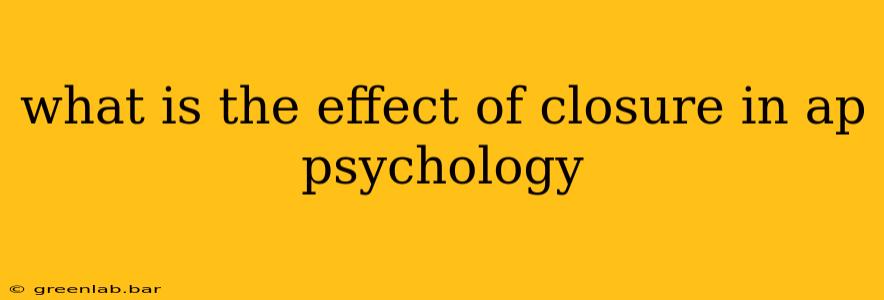Closure, a fascinating Gestalt principle, plays a significant role in how we perceive and interpret the world. Understanding its impact is crucial for AP Psychology students, as it touches upon several key concepts related to perception, cognitive processes, and even social psychology. This post delves into the effect of closure, exploring its definition, underlying mechanisms, real-world examples, and its implications in various psychological contexts.
What is Closure in Gestalt Psychology?
In Gestalt psychology, closure refers to our brain's innate tendency to complete incomplete figures or patterns. We mentally "fill in the gaps" to create a whole, meaningful perception, even when presented with fragmented or incomplete sensory information. This isn't a conscious process; it's an automatic, unconscious completion that happens effortlessly. The brain actively seeks wholeness and order, preferring complete forms over fragmented ones.
The Mechanism Behind Closure
While the exact neurological mechanisms are still under investigation, closure is believed to involve several brain areas working in concert. These include areas associated with visual processing (like the occipital lobe), memory retrieval (hippocampus), and higher-level cognitive functions (prefrontal cortex). The brain uses past experiences, expectations, and context to infer what is missing and construct a coherent image. This explains why we can easily recognize a logo even if parts of it are obscured.
Real-World Examples of Closure
Closure's impact is visible in numerous everyday situations:
- Incomplete shapes: We readily perceive a circle even if a small segment is missing. Think of a partially hidden object – our minds complete the unseen parts based on the available information.
- Logo recognition: Many famous logos use the principle of closure. They might be partially obscured or presented in a fragmented way, yet we immediately recognize them because our brains fill in the missing pieces.
- Reading and writing: We often misread or misinterpret words with missing letters or typos, yet still understand their meaning thanks to closure. Our brains automatically compensate for these imperfections.
- Incomplete sentences: We can understand the gist of a sentence even if a few words are missing. This is because our brains use the context and surrounding words to fill in the blanks.
- Social perception: We often make assumptions about people's personalities or intentions based on incomplete information, relying on closure to complete the picture. This can sometimes lead to inaccurate judgments.
Implications of Closure in AP Psychology
Understanding closure's impact extends far beyond basic perception:
Cognitive Psychology: Closure demonstrates our brain's powerful pattern-recognition abilities and its tendency to simplify complex information. It’s a fundamental aspect of how we process and make sense of the world around us.
Social Psychology: The concept is relevant in understanding how we form impressions of others. Our tendency to fill in gaps in our knowledge can lead to stereotyping and biases in social judgment.
Clinical Psychology: In cases of visual agnosia (inability to recognize objects), understanding closure can help clinicians assess the extent of impairment in visual processing.
Developmental Psychology: The development of closure abilities highlights the maturation of the brain's perceptual and cognitive systems. Children gradually learn to interpret incomplete information as they mature.
Conclusion: The Significance of Closure
Closure is a fundamental Gestalt principle with far-reaching implications across various areas of psychology. Its influence on our perception, cognition, and social interactions highlights the remarkable efficiency and adaptability of the human brain. For AP Psychology students, grasping this principle offers a key insight into the complexities of human perception and the powerful role of our inherent cognitive biases. By understanding closure, you can better appreciate the intricate interplay between sensation, perception, and our subjective experience of reality.

